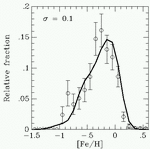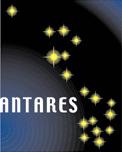The K dwarf problem
Our Milky Way is a typical
spiral galaxy containing a disk of a few 100 billion stars. Most stars
are known to consist mostly of Hydrogen, a little Helium and a very
little of everything else, the so called "metals". The metals
typically add up to only a few percent of the star by weight.
Now astronomers at Tuorla
Observatory have measured the amount of the metals in a very
representative set
of stars near the Sun, more accurately than ever before. The
distribution confims a major puzzle: it isn't at all like one would
expect from simple ideas about how metals are produced in galactic
environments.
The team ( Chris Flynn and Eira
Kotoneva of Tuorla Observatory
) used archival data from the European Space Agency's Hipparcos
satellite. The team examined K dwarfs stars, which
are much like the Sun except that they are cooler and not quite
as heavy. The stars are very plentiful nearby the Sun, so getting
a good sample of all the nearby ones wasn't difficult. While analysing
the stars, they discovered that there is a simple and elegant relation
between the luminosity of the stars and their metallicity. The
relationship uncovered is remarkably tight -- and has since been
used for to measure not just the metallicity of the stars, but also
their Helium content . The relationship
with metallicity has been long predicted by stellar theory: this is the
first confirmation using accurate observations.
The surprise about the
distribution of elements in nearby stars is that it doesn't at all
follow the expectations of the simplest theories of how the stars in
the Milky Way galaxy were born and developed during its long lifetime
of some 10 billion years. Our picture of how galaxies were born is that
they were assembled from massive gas clouds which collapsed under
gravitational attraction. At first, the gas was mainly Hydrogen and
Helium: i.e. very little of the other, heavier elements was created in
the Big Bang. As time
progresses, stars are born and die, and they produce elements in their
cores; these elements, many critical to life on Earth (such as Carbon,
Oxygen,
Iron, Magnesium and Silicon) are spread back into the surrounding gas
clouds
when the some of the stars explode as supernovae (and similar
processes).
Over the history of the Milky Way, the amount of these heavy elements
has
been slowly building up -- there should be quite a range of
metallicities
from the youngest to the oldest stars. At least, that was the
expectation:
in fact, most stars near the Sun have a metal content very much like
the
Sun: this was first noticed in the 1960s and was prosaically termed the
"G-dwarf problem", after the type of star (G dwarfs) in which it was
seen.
The team at Tuorla have now
shown that the same problem exists in K dwarfs: they see exactly the
same effect as the G dwarfs. K dwarfs have a definite advantage over G
dwarfs though. They have lower masses and are dimmer than G dwarfs; as
a consequence, they have hardly changed inside since they were born,
even if they were born as long as 10 billion years ago: they are a true
fossil record still of what they were like when they were born. We can
really use them to follow how star formation, metal production and the
amount of gas in the Milky Way
has been changing since the galaxy was born.
The research has been published
in the Monthly Notices of the Royal Astronomical Society.
|
The DIRBE view of our Milky Way Galaxy
showing the disk (seen edge on) and the central bulge. The Sun is
located some 30,000 light years from the central region, so that from
our vantage point on the Earth we get a spectacular view of our own
galaxy as we 'look in'.

|
